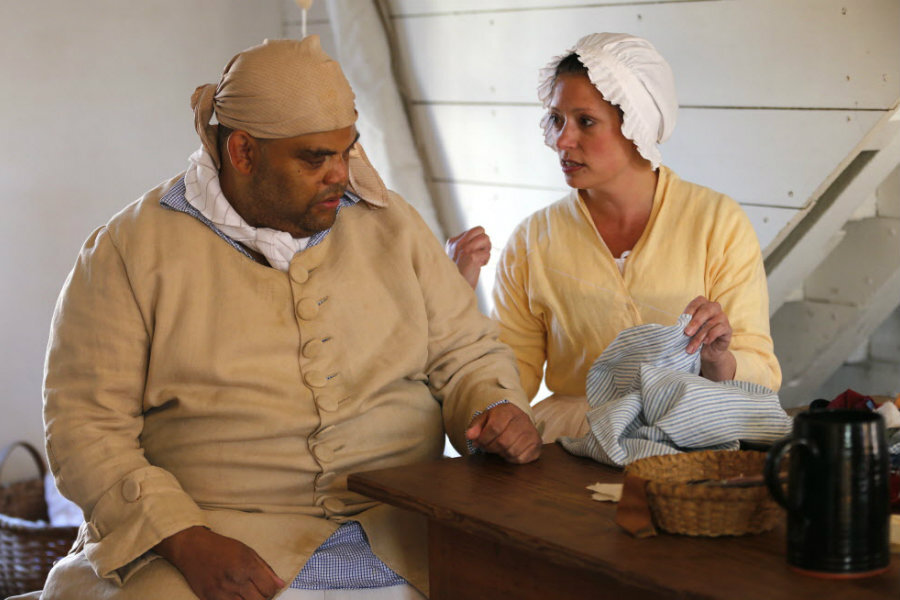Colonial Williamsburg ad evokes 9/11: tasteful tribute or blatant exploitation?
Loading...
A Super Bowl ad touting tourism in Colonial Williamsburg has drawn both praise and ire for using imagery of the Sept. 11, 2001 attacks on the World Trade Center.
The commercial, which aired in New York, Philadelphia, and Washington, D.C., after halftime Sunday night and was a first for the living-history museum, has narrator Tom Brokaw calling on viewers to “reflect upon our sacrifices, our breakthroughs, and yes, our heartbreaks” – at which point footage of one of the twin towers crumbling down is shown in reverse.
The resulting social media outcry again calls to question the line between tasteful tribute to and commercial exploitation of a tragedy. The events of 9/11 in particular – because of both their gravity and recency – have been the center of debate about when commemoration crosses the line into profiteering.
Almost immediately, a slew viewers took to Twitter to express concerns about the ad:
A similar furor took place when the National September 11 Memorial & Museum – built on the site where the twin towers once stood – opened to the public in May 2014. The presence of an on-site gift shop, as well as plans for a restaurant overlooking the artifacts from 9/11, prompted a loud outcry from family members and critics alike, as The Christian Science Monitor’s Harry Bruinius reported at the time.
“It's not right, selling dog raincoats to commercialize the deaths of 3,000 people,” wrote David Cutler, a guest columnist for a consortium of Cleveland news organizations. “When you're on sacred ground, where victims jumped to their deaths from the burning towers, the idea of someone buying a black and white 'Darkness Hoodie' for $39, at that very spot, seems vile.”
Museum representatives at the time defended the decision to sell souvenirs at the site, with then-spokesman Michael Frazier pointing out in a statement that “many of our guests from the 9/11 community have visited the shop and purchased a keepsake from their historic experience.”
Colonial Williamsburg has done the same, emphasizing the importance of remembering the best and worst of the past in growing as a nation.
“Our ad is meant to walk viewers backwards through time, challenging them to reflect on how our collective history and struggles shape who we are as Americans today,” Colonial Williamsburg posted in a statement. “We cannot forget our sacrifices or our tragedies even as we celebrate our accomplishments. Colonial Williamsburg does not shy away from these difficult moments in our history because they have made us who we are just as surely as our many triumphs.”
And some agreed with the message that Colonial Williamsburg says it was trying to make.
“Wonderful commercial Colonial Williamsburg!” one commenter wrote on the museum’s Facebook page. “Guess what folks – people have died in most of the events that were shown there. That's the point – it's about our nation's history, the good and bad we have gone through, and where it all started!!”
“Thank you, CW, for this thought-provoking, respectful method of bringing many highlights of this great country's history to a wide audience,” another added.
There may be at least one other point of view, as well. In a post on his blog, Andy Schocket, a professor of history at Bowling Green State University in Ohio, questions Colonial Williamsburg’s use of 9/11 footage instead of other heartbreaking or difficult moments in America’s past – such as the Oklahoma City bombing or the use of hoses on black protesters on the bridge in Selma, Ala.
Part of it has to do with the fact that, even if only shown for a fraction of a second, the 9/11 shot is pretty memorable.... I’ll tell you my theory, though, beyond recognizability of a particular moment: CW chose 9/11 because it was heartbreak caused by foreigners, rather than inflicted by Americans, on Americans.
In other words, despite its claim to be “challenging” Americans, CW is still ... not asking us to face our own failings. Rather, as in this ad, it still portrays American history as a story of uninterrupted progress in which obstacles were overcome by heroism, without noting that, in most cases, those obstacles were made by some of us Americans wanting to exploit our fellow Americans.






